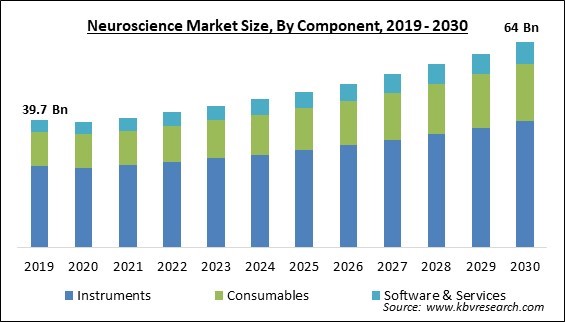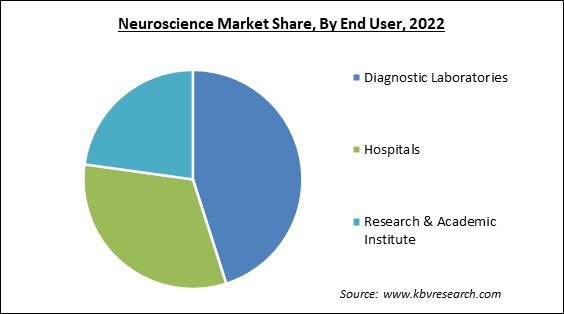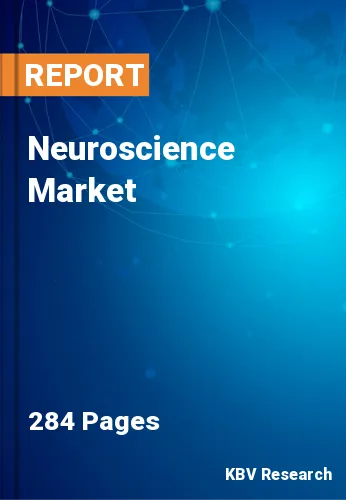The Global Neuroscience Market size is expected to reach $64 billion by 2030, rising at a market growth of 5.5% CAGR during the forecast period.
Neurological diseases are common among older adults, with a prevalence rate ranging from 5% to 55% in individuals aged 55 and above. These conditions account for over 37% of the years of healthy life lost due to disability among adults aged 15 and above. Therefore, the Stereotaxic Surgeries segment would capture 1/5th share in the market by 2030. Stereotaxic neurosurgery (or stereotactic brain surgery) is the method of finding surgical targets within the brain relative to an external frame of reference. Previously, accomplishing this required momentarily fastening a mechanical frame to the patient's scalp or skull. Typically, this surgery aims to eliminate an anomaly identified by an MRI or CT scan. Recent developments in computing are enhancing these methods to enable greater surgical planning and intraoperative information.

The major strategies followed by the market participants are Partnerships as the key developmental strategy to keep pace with the changing demands of end users. For instance, In July, 2023, GE HealthCare Technologies, Inc. signed a partnership with Elekta to provide radiation therapy solutions within the Indian market. The partnership expands GE HealthCare's oncology offerings and would allow it to provide an efficient cancer care portfolio to Indian customers. Additionally, In January, 2023, Koninklijke Philips N.V. partnered with Masimo, to integrate its patient monitoring portfolio with Masimo W1.
Based on the Analysis presented in the KBV Cardinal matrix; Danaher Corporation and Abbott Laboratories are the forerunners in the Market. Companies such as Terumo Corporation, Medtronic PLC, Stryker Corporation are some of the key innovators in the Market. In April, 2023, Medtronic PLC partnered with Qure.ai, to provide advanced solutions for stroke management in the Indian market.

The COVID-19 pandemic had a severe impact on the world's economy. The outbreak has affected almost all industries, either positively or negatively. The market was negatively impacted by the pandemic outbreak in the initial months. Most countries faced more pressure to improve their mental health services because of the pandemic. Despite an established late-stage pharmaceutical pipeline, the COVID-19 pandemic also hampered clinical trial procedures, R&D, and pipeline products, and these factors had a negative effect on the growth of the market. Therefore, despite the negative impact on the market during the early stages, the market will experience rapid growth in the coming years.
Rising government spending on healthcare infrastructure in developed nations is predicted to drive the growth of the market. For example, Medicare spending increased by 8.4% to $900.8 billion in 2021, or 21% of all national health expenditure (NHE), and Medicaid spending increased by 9.2% to $734.0 billion, or 17% of all NHE, according to the Centers for Medicare and Medicaid Services. In the U.S., interest in all medical devices, including brain equipment, will rise due to this rising trend in government spending. Therefore, the availability of reimbursement of neuroscience treatment in most nations is significant factor propelling the growth of the market.
The most effective imaging and neuroscience research tool is magnetic resonance imaging (MRI). In addition to the exceptional functional details of the central nervous system (CNS), it offers morphological images with the highest quality spatial resolution and unmatched soft tissue contrast. A project to develop and implement a novel real-time functional magnetic resonance imaging (rt-fMRI)-based neurofeedback (NF) training paradigm was initiated, according to a research study titled "A Novel Brain-Computer January 2021 publication of "Interface Virtual Environment for Neurofeedback During Functional MRI." Therefore, the rising research and development in this filed is expected the drive the growth of the market.
The brain appears to be the most complex compared to other human bodily organs. Research indicates that a significant portion of the human genome contributes to the development of brain structure, connectional patterns, and neurochemistry. The brain is responsible for many functions, including movement induction, sensation mediation, and control over other bodily organs. Its operation provides the basis for perception, cognition, emotion, and creative expression. Neuroscience also needs to account for the variations among people brought on by environmental and inherited variables. Hence, the complexity of how these components interact and contribute to different brain processes presents a significant obstacle that limits market expansion.
On the basis of component, the market is segmented into instruments, consumables, and software & services. In 2022, the instruments segment dominated the n market with the maximum revenue share. The growth of the segment is due to the arrival of new instrument equipment for detecting and treating neurological illnesses. A specific kind of instrument used in neuroscience is an optogenetics device. Other types include microscopy devices, electrophysiological instruments, and MRI equipment.
By end-user, the market is classified into hospitals, diagnostic laboratories, and research & academic institute. In 2022, the diagnostic laboratories segment registered the highest revenue share in the market. The broad range of neurological devices' applications in diagnostic laboratories and the public's growing awareness of the benefits of early disease diagnosis are attributed for the growth of the segment. Using electroencephalograms (EEG), electromyograms (EMG), CT scans, MRIs, and other neurological diagnostic tools is common in diagnostic facilities.

Based on technology, the market is fragmented into brain imaging, neuro-microscopy, stereotaxic surgeries, neuro-proteomic analysis, neuro-cellular manipulation, and others. The neuro-microscopy segment garnered a significant revenue share in the in 2022. The demand for neuro-microscopy is rising due to the increasing rate of technological development in areas like genetic cell labeling and optogenetics. To observe the nervous system at the cellular and subcellular levels and to contextualize any molecular modifications, microscopy techniques are essential.
| Report Attribute | Details |
|---|---|
| Market size value in 2022 | USD 42.1 Billion |
| Market size forecast in 2030 | USD 64 Billion |
| Base Year | 2022 |
| Historical Period | 2019 to 2021 |
| Forecast Period | 2023 to 2030 |
| Revenue Growth Rate | CAGR of 5.5% from 2023 to 2030 |
| Number of Pages | 284 |
| Number of Table | 384 |
| Report coverage | Market Trends, Revenue Estimation and Forecast, Segmentation Analysis, Regional and Country Breakdown, Competitive Landscape, Companies Strategic Developments, Company Profiling |
| Segments covered | Component, Technology, End Use, Region |
| Country scope | US, Canada, Mexico, Germany, UK, France, Russia, Spain, Italy, China, Japan, India, South Korea, Singapore, Malaysia, Brazil, Argentina, UAE, Saudi Arabia, South Africa, Nigeria |
| Growth Drivers |
|
| Restraints |
|
Region wise, the market is analysed across North America, Europe, Asia Pacific, and LAMEA. In 2022, the North America region witnessed the largest revenue share in the market. The growth of the market in this region can be attributed to the region's significant concentration of companies involved in creating, manufacturing, and distributing technologies used to diagnose and treat neurological patients. The primary drivers of market expansion in this region are the rise in disease prevalence and awareness, as well as the presence of key market participants.
Free Valuable Insights: Global Neuroscience Market size to reach USD 64 Billion by 2030
The market research report covers the analysis of key stake holders of the market. Key companies profiled in the report include Carl Zeiss AG, Danaher Corporation, Koninklijke Philips N.V., GE HealthCare Technologies, Inc., Terumo Corporation, B. Braun Melsungen AG, Medtronic PLC, Stryker Corporation, Boston Scientific Corporation and Abbott Laboratories
By Component
By Technology
By End User
By Geography
This Market size is expected to reach $64 billion by 2030.
Favourable reimbursement for treatments and neuroimaging are driving the Market in coming years, however, Complexity of the brain restraints the growth of the Market.
Carl Zeiss AG, Danaher Corporation, Koninklijke Philips N.V., GE HealthCare Technologies, Inc., Terumo Corporation, B. Braun Melsungen AG, Medtronic PLC, Stryker Corporation, Boston Scientific Corporation and Abbott Laboratories
The expected CAGR of this Market is 5.5% from 2023 to 2030.
The Brain Imaging segment is leading the Market by Technology in 2022; thereby, achieving a market value of $16.3 billion by 2030.
The North America region dominated the Market by Region in 2022 and would continue to be a dominant market till 2030; thereby, achieving a market value of $22.8 billion by 2030.
Our team of dedicated experts can provide you with attractive expansion opportunities for your business.

